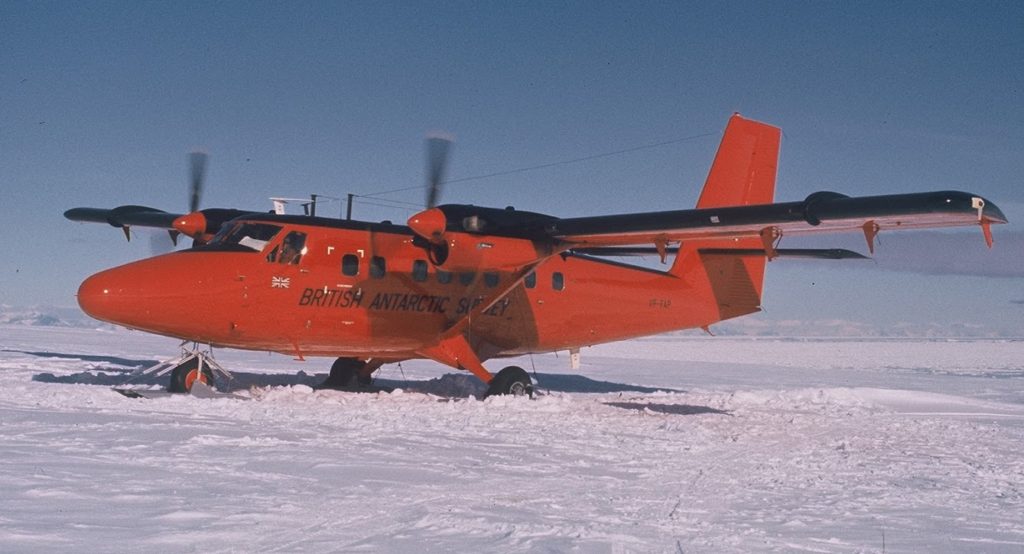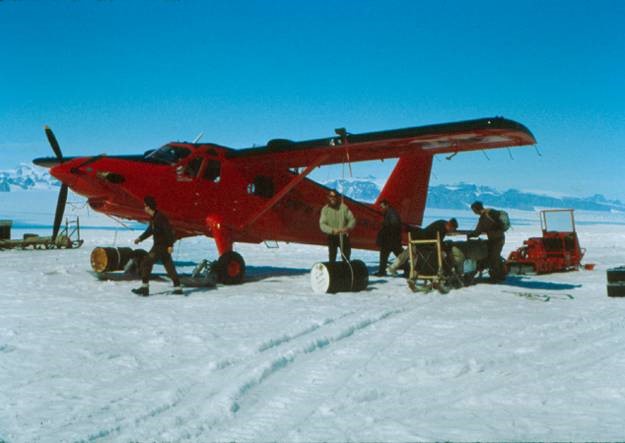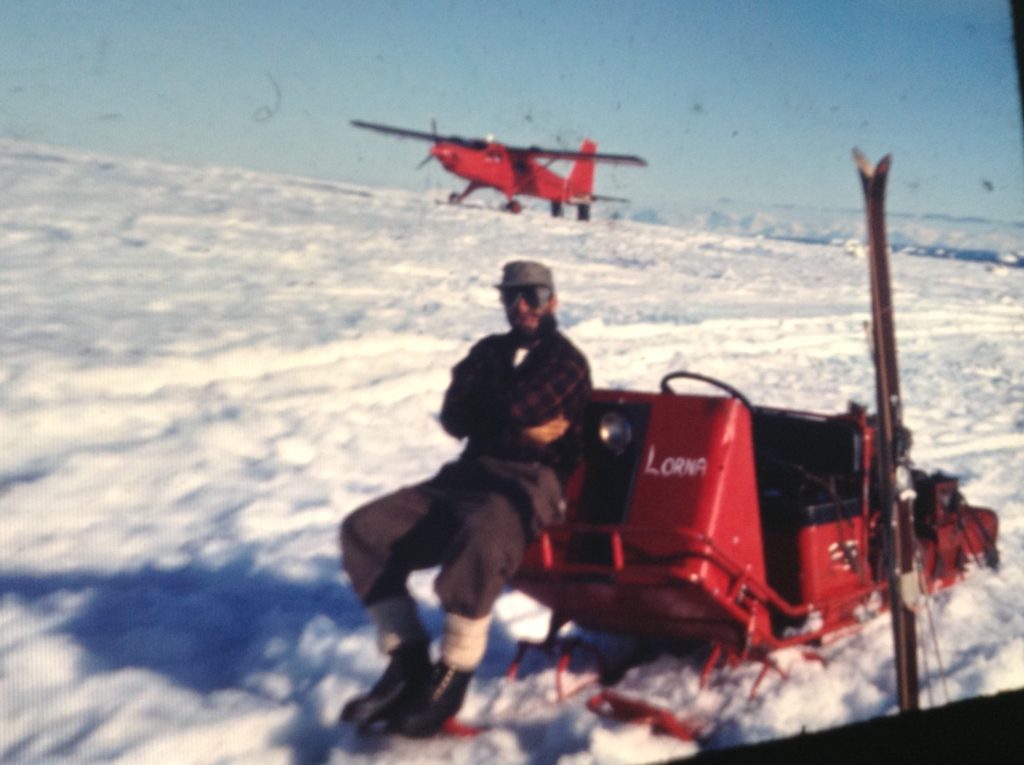December 7th – B.O. & Seal Stink – Dave Rowley
We (me, Flight Lieutenant Bert Conchie, Sergeant Dave Brown and Sergeant Alec Simon), the latter being helicopter engineers seconded from Middle Wallop Army Airbase near Salisbury, ferried the Twin Otter and Beaver aircraft from Toronto (De Havilland’s factory) through North and South America to Adelaide .

Flt. Lt. Bert Conchie and myself joined BAS together. He was the last RAF pilot to be seconded to BAS and as the first civilian commercial pilot, HQ put me in charge of the Air Unit with strict instructions that Adelaide Base Commander, Ian Willey, would determine which flights took priority, and would have the last say on whether met. conditions where safe for flight operations . After a disastrous loss of aircraft in previous seasons, HQ were keen to curb any excess of “Gung Ho” enthusiasm on the part of the Pilots .
Continuing from Adelaide page and Air Unit page
Bert and myself worked really well together for 5 summer seasons. When he returned to his unit after BAS, Bert was promoted to Group Captain prior to retirement.
After our 2 week conversion course in Toronto, we set forth south, stopping at Fort Lauderdale to have long range ferry tanks fitted by a company called Red Aircraft who were experts in the business.
The Twin Otter had already done one season down south and was nearly lost on the Larson Ice Shelf, – see separate story! However, BAS bought the single-engined Turbo Beaver as a backup aircraft and employed a retired U.S. Army airforce pilot to ferry it south. He was accompanied by Alec Simon while the other three of us occupied the Twotter.

(I had first become involved in the Antarctic in 1957 when the IGY (International Geophysical Year) support piston Otter, piloted by Sdn. Ldr. John Lewis, was flown into RAF Colerne in Wiltshire before it was transported South, where I was serving my National Service as a Leading Aircraftman Airframe Fitter on No.49 Maintenance Unit, Special Installations Squadron.
There we fitted a Wilde Drift Sight between the Pilots’ seats, plus a few other modifications. During that time, Lewis talked to me and the team extensively about IGY , so we got an exclusive preview! That was before I was posted to Singapore to a similar unit , where I gained my PPL at the Royal Singapore Flying Club as a hobby. Little did I know that I would be a Commercial Pilot with BAS a mere 12 years later.)
Anyway, back to Punta Arenas. We had a our “last meal” – Spider Crab – Bloody great thing that the owner of the restaurant let loose to run around the floor clattering from table to table. It must have been 5 feet across but it didn’t put us off consuming the bugger.

My flying log book says that on my first flight south, I left Punta Arenas at 1210. After Punta, we landed at Anvers Island to drop off the Yank to catch a ship home while Bert and Alec flew the Turbo Beaver to Adelaide.
I can’t lie about my relief on recognising the north end of Adelaide and flying down the west coast to Base T. The ‘beacon’ was on , but I couldn’t pick it up, however the base showed up well in the low sun . I did a couple of turns around the base and picked out the North South airstrip marked by a single line of oil drums. I decided to land toward the north over Avian Island and the ice cliff, thinking in my in experience of snow surfaces, that if I landed the other way, I might go over the ice cliff if I couldn’t stop!
Myself and Dave Brown landed at Adelaide at 20:15. Bert and Alec arrived shortly afterwards in the Beaver, and we and the enthusiastic Fids tied the aircraft down to the previously buried “dead men”. The Fids overran the aircraft and stripped it of anything edible – including eggs, butter, vegetables and anything else that we bought from Punta! Ian (Willey), the Base Commander, arrived to sort out the mayhem and I was escorted down the Piedmont to the Base, showed my bunk and issued a ‘P’ bag!
Our arrival on base could not have been more welcoming. But having had a shower and a meal of Spider Crab and Salad eight hours earlier, I thought “What the shit I had got myself into” – the stink of body odour and seal was overwhelming – I felt that I must have smelled so good that my virginity was at risk.
The bar was opened (I later learned it was open because it was Saturday, Scrub-out Day**) and after being shown our bunks, we had a night of getting to know each other, necking lots of Newcastle Brown Ale, and in my case, pints of Gordon’s Gin, topped up with lime cordial and snow. I discovered that Gordon’s was used to de-ice the windows and that there were cases full of the stuff in the loft. I felt comfortable and at home that night! There was an altercation between the Radio Operator and a Met Man, festering tensions from the winter, but soon resolved , and calm restored…..

We had a “blow” that same night and Ian drove me up to the airstrip to check the aircraft. All was OK, but recognising my shivering state on return to the base, Ian insisted that I had a hot shower, despite my protestations that I was still fragrant from Punta Arenas. I slept the sleep of the lnnocent after an 18 hour day, in my newly issued sleeping bag!
** – Note – the Bar was open pretty well every night!
After the blow, the next morning we all went up to the airstrip to assess the damage.
At our induction at Cambridge during Summer of ’69, we were so convinced that unless the aircraft were tethered by a 1000 tons of lead, they would be blown away in a blizzard. To our relief they stood there intact, buried up to their bellies in snow . Even without the dead men, they wouldn’t have gone anywhere, can you imagine a ski area of about 40 square feet under 3 feet of snow going anywhere?
Anyway , after assessing all was well, the base got on with its duties while the four of us dug out the aircraft, a good mornings work.
The rest of the day was taken up with removing the ferry tanks and clearing the cabin ready for freight. Weather was marginal for flying, but there was plenty to do.

(Photo: Rob Campbell-Lent)
We had a couple of days of learning the ways of Base life . We were introduced to the roster: cook, dish washer, gash and shit bucket run (to the jetty), snow block cutting (avoiding the yellow bits), and of course, the dreaded seal pile .
Good old Ian Willey, the Base Commander told the Air Party that we could hold fire on seal chop until we got used to the smell, but me and Bert got together with Dave Brown and Ron Ward, the other Airmech; and decided that we wouldn’t let the side down.
The first seal chop was pretty traumatic, but I was proud to smell like everybody else at smoko that day.
Of course, we couldn’t wait to get airborne, and at 2115 GMT, l flew a FID to Anvers Island, a flight of two hours. I wish that I had included names in my log book. The return flight took 1 hr 30 mins landing at 0115, obviously a good Northerly. That was 10 / 11 December ’69 , with a ton of freight from John Biscoe to T.
The afternoon of the 11th. Was dingle clear and my introduction to real Antarctic flying began. Take off T. 1555 to KG . T/O KG 1910 to Titania. T/O Titania 2000 to KG. T/O KG 2035 to E. T/O E. 2255 , landing at T 2325. After an hour of refuelling and tying down the Twotter in the freezing sunset, I collapsed in my bunk, happy and in awe of the wonderful things I had seen, and slept the sleep of a babe .

The airwaves on that day were alive with requests for air support. I remember Sean Norman and Base T plus the sledges all vying for support, and just being happy to go where I was asked to go. Halcyon days, thanks BAS.
The aircraft unit, Twin Otter and Beaver, set a record that Summer flying season. After several years of “depot marking” using other aircraft, both planes transited back to De Havilland Canada without damage, and BAS replaced the Beaver with a second Twin Otter for the following season.
Dave Rowley – Pilot – Adelaide Air Unit – 1969 – 1973
